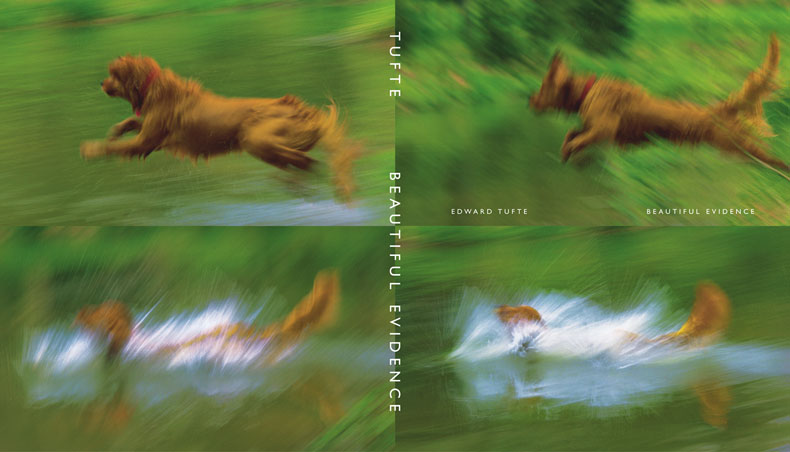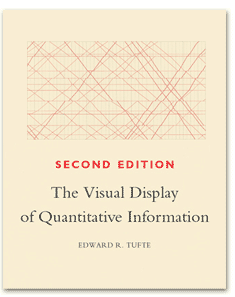

Beautiful Design (2006, Graphics Press LLC, Cambridge USA) is Edward Tufte's fourth book in a series discussing and analysing the visual presentation of data. According to the introduction, there is a fifth volume planned.
Beautiful Design is a really lovely and luxurious volume, copiously illustrated throughout. I read this book immediately after The Visual Display of Quantitative Information, and unfortunately I have to say I was a little disappointed by the comparison. Minard's Grande Armee chart makes a reappearance, not once, not twice, but five times in this volume! This is within a nice chapter describing a set of principles of analytical desig (there are six in all). As usual, Tufte can get a little didactic, but I found that, while I perhaps disagree with his stonger statements, he's always an entertaining read, exemplified by his deconstruction and explanation of Minard's graphics
The major contribution here is the sparkline, small graphics intended to be embedded in text and tables. In fact they are just the sort of thing we see in many genome mapping papers where considerable quantities of data need to be clearly communicated in summary fashion. Tufte's website hosts a forum with an interesting discussion of sparkline implementation.
Tufte devotes an entire chapter to the evils of PowerPoint. He absolutely HATES it! Entitled The Cognitive Style of PowerPoint: Pitching Out Corrupts Within, it is available as a separately published pamphlet. Now, while I agree one does sit through some desperately bad PowerPoint presentations, I am not so convinced of the evils of this package as Tufte is. Nevertheless, his design strictures against Autocontent Wizards, design templates, seemingly infinitely hierarchical bullet points make good sense. More about this in a later post.
So, in summary, I'm finding this an interesting read, but rather less informative in an instructional way than Visual Display. Not essential.
Pros - It's open source. Easily installed from the Ubuntu repositories, which simplifies the installation of dependencies. A KDE GUI, KeyjnoteGUI, is available, which streamlines startup considerably.
Uses either a pdf file, or a directory of images - I've used the latter.
Transitions are very nice, though their smoothness depends on your hardware. Nicest on my Vaio laptop is "Crossfade".
You can script timings and effects in an .info file
A variety of neat highlighting and spotlighting effects are available while the presentation is underway.
Cons - No simple slide organiser
Would be nice to have a "next slide preview facility"
Update 20/01/08 - last Monday I gave a talk at a local school using KeyJnote. It worked pretty well, with pleasing crossfade transitions. The green "timer bar" that indicates where you are in the presentation starts runnign as soon as you set the presentation up. Since there was a delay in actually beginning the presentation, the bar wasn't much use (when I started the presentation, the bar had already advanced to about 10 minutes!). I don't know if there''s a way to work around this. I was presenting a series of jpgs, rather than a pdf document, which i haven't got to work yet. The only real issue was with the projector cropping the slides, but this is mainly due to the xrandr settings, I suppose.

The first ever Oor Wullie annual, first published in 1940, has just been reprinted in facsimile edition.
Another in D. C. Thomson's reissues of Dudley D. Watkins' classic comic books, which I received for my birthday this year. Thomson published The Broons and Oor Wullie strips in the weekly paper The Sunday Post, and compiled annuals from the strips - The Broons and Oor Wullie annuals appeared (and still do) on alternate years. Personally, I far prefer Oor Wullie - I think The Broons tends to use very repetitive story lines.
The artwork in this facsimile edition is fantastic, there's a really dynamic sense of action. The stories? Well, the stories are pure classic Wullie action! There's a link to a scan of the first ever Wullie story below.
Wullie's web links:
Oor Wullie at Wikipedia
A Wullie and Broons fan page, which also has a lot of material about Dudley D. Watkins.

I recently bought a copy of The Visual Display of Quantitative Information by Edward R. Tufte (Graphical Press LLC, Cambridge, USA). Tufte's website gives quite a bit of information on his publications.
Edward Tufte has written several books, generally on the effective graphical display of data. This volume is the first of a series of four, and was originally published in the late 80s (I have the second edition, fourth printing, 2006), before the appearance of Microsoft's PowerPoint application. As I shall discuss in a later article, Tufte is vehemently opposed to the use of PowerPoint. (My own opinion is that PowerPoint enables one to quickly prepare a presentation: how effective the presentation depends largely on how much forethought has been devoted to the presentation before composition starts). More on the PowerPoint debate in a later article, perhaps.
Here, Tufte provides a clear and frankly beautiful exposition on the display of information. In Part 1, he presents examples of graphical excellence, including something of a historical treatment. Significant here is what must be his favourite chart, Minard's chart of Napoleon Buonaparte's disastrous Russian campaign of 1812. Tufte just loves this chart, not only does it feature in this book, but it reappears five times in Beautiful Evidence, the fourth book in this series - I will review this book as well. Tufte follows these examples with a chapter extolling the need and virtue of Graphical Integrity, in which he gives a variety of examples of dubious data presentation.
However, it is in Part 2 that we see the real meat of the text, and we are provided with clear guidance for best chart design, through six chapters. I have to say that for me at least eventually his strictures against too much ink on charts go a little too far, and deviate far enough from normal styles of data presentation that they become rather harder to comprehend.
Overall this book would score the highest marks for presentation, content, and general interest. Very highly recommended.